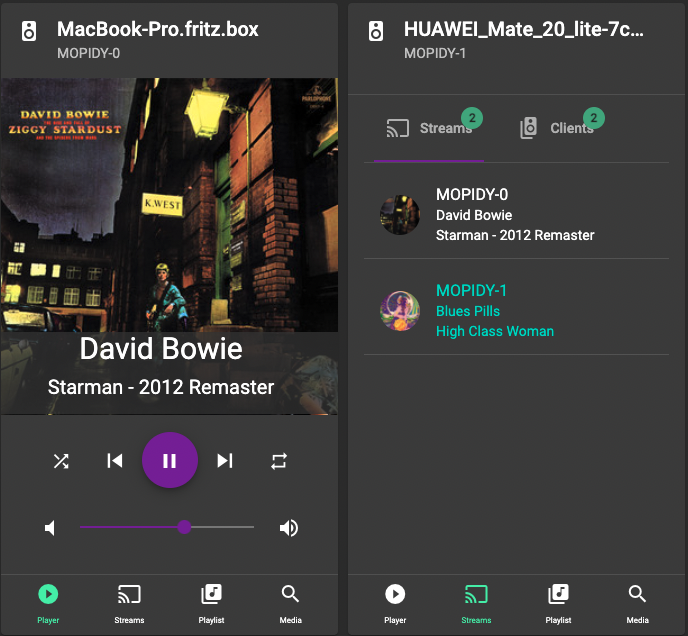HydraPlay is an easy to use multiroom audio player. HydraPlay provides an integrated web interface to multiple Mopidy instances and one Snapcast server. It generates all the complex configurations under the hood. Only one configuration file is needed to define what the user needs.
The server part is written in Python and provides a webserver for the frontend delivery. Besides that the server generates all configurations and cares about starting Mopidies and Snapcast.
The Frontend is written in TypeScript with the usage of Angular. It connects to the Mopidy and Snapcast web API's to combine all the fancy functions in one user interface.
HydraPlay was inspired by a project i have found on Youtube by Ryan Detzel.
This project is still under development, some things might be unstable
The scnreenshots below show two connected players and a configuration with two (default value) Mopidy instances.
The following steps require Docker and Docker Compose to be installed on your system.
Make a copy of the file hydra.example.json and rename it to hydra.private.json. This file contains all needed configurations for the setup.
Open the file in an editor and make your changes. If you want to enable Spotify you need a client_id and client_secret. Just follow the instructions of the Mopidy Spotify extension. Add the cliendId, client secret and your Spotify login credentials to the config. Enable Spotify and save all changes.
Now you are able to start the server with:
platform: linux/amd64 in the docker-compose.yml file.
docker-compose up
Connect a SnapClient to the server.
The fastest way is by using the integrated webclient. Open a browser and go to
http://<your_server_ip>:<port_in_configuration>/client/
Click on the play button on the top right corner in the window.
Your client should be connected to the server ( you can proceed with the next step)
Alternatively use a more stable generic client on your client-side systems (e.g Raspberry Pi)
snapclient -h <server_ip>
Detailed information can be found on the offical Snapcast GitHub project documentation.
Or even install the official android client on your mobile phone
https://github.com/badaix/snapdroid/releases/tag/v0.24.0
Finally open a Browser and goto:
http://<your_server_ip>:<port_in_configuration>
If you like my work and want to support it, feel free to leave a donation.

This section describes the HydraPlay cofiguration file hydra.example.conf
port: defines the web port on which hydraplay will be available in the browser. Defaults is 8080
source_type: Defines which type of audio source should be used between mopidy and snapcast. Possible values are fifo and tcp. Defaults is tcp.
config_path: Defines the path to the generated Snapserver config file. Default for Docker usage is /tmp/,
server_port: Default is 1704
remote_port: Default is 1705
additional_fifos: Will be used for additional sources but is not implemented yet. Default is [],
codec: Defines Snapcsats audio codec. Possible values are flac, opus, ogg, pcm Default is flac
mpd_base_port: Default is 6600
web_base_port: Defines the web API port for Mopidy. This port is used by HydraPlay for connecting to the Mopidy web API. The first instance equals to this port. For all further instances the port is increased by a count of one. Default is6680
instances: Defines the number of stated Mopidy instances. Each instance represents one stream in HydraPlay. A good
starting point would be number of instances equals number of clients. Defualt is 2
config_path: Defines the folder where HydraPlay generates the Mopidy configurations. Default is /tmp/,
TODO
If you want to do some development on the ui you can use a local docker dev image for keeping things easy. The dev image is almost the same as the production image but it does not contain a pre-compiled version of the ui. Therefore the image build process is much faster. Just run
docker-compose -f docker-compose.dev.yml build
platform: linux/amd64 in the docker-compose.yml file.
Afterwards you can fire up the development environment by
docker-compose -f docker-compse.dev.yml up
Now you can proceed whit "Build the Angular Frontend"
nodejs is required before you can proceed. After you've installed nodejs you can build the ui by using:
cd src/ui
npm install -g @angular/cli -g
npm install
ng build
You can run ng build with the additional argument --watch for live
re-compiling while you are working on your code.
The build folder is located at /src/hydraplay/server/static/player
You can build a production image instead downloading by using:
docker build -f docker/Dockerfile -t mariolukas/hydraplay --build-arg SNAPCASTVERSION=0.26.0 .
platform: linux/amd64 in the docker-compose.yml file.
You can find a blog post. which i wrote a couple of years ago when i started the project. A lot of things changed since the first setup. But it will give you and idea on how it works under the hood. ( the blog post describes the very first prototype! )
- mdns/avahi does not work within docker. You need to start your clients with the -h <ip_address_of_server> parameter.
Play/Pause button will not change back after a track was completed. Somehow there is no Mopidy event incomming for EndOfTrack.(works with tcp sources)
- add debian package config and make file
- add build script for raspberry pi image
- add more documentation ( for Raspberry Pi, MacOS with m1, run without docker, configuration etc. )
- provide ready to use pre-build docker images
This project would not have been possible without all the work on Snapcast and Mopidy! Special thanks to Ryan Detzel for the inspiration.
Join us at Discord (https://discord.gg/xs9CKfbpuY).




